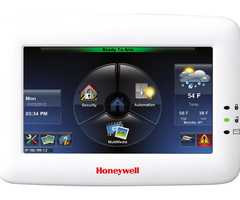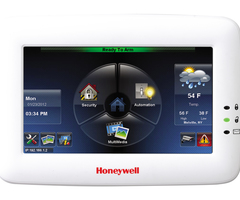The Tuxedo Touch Keypad: Disarming
Related Products


Related Categories
Description
In this video, Jorge from Alarm Grid shows you how to disarm your Honeywell VISTA Security System using a Honeywell Tuxedo Touch Keypad. One of the primary functions of the Honeywell Tuxedo Touch is to serve as a keypad controller for a Honeywell VISTA. You use the keypad to check the current status of the system and to perform security system functions like arming and disarming. You can also use the Tuxedo Touch to bypass zones, and you can go into its special Console Mode to make deep-level programming changes to the system.
Disarming represents one of the most common actions you will perform on a security system. When you are disarming the system, you are taking it out of its secured, armed state. Certain zone types can only cause system alarms while the system is in an armed state. For example, zones with a Response Type of Perimeter, Entry/Exit, and Interior Follower can only trigger an alarm when the system is armed. When the system is disarmed, only 24-hour zones can trigger alarms. Examples of 24-hour zones include 24-hour audible, 24-hour silent, 24-hour fire, 24-hour carbon monoxide, and 24-hour auxiliary.
In order to disarm the system and take it out of its secured armed state, you will be required to provide a valid code. This code proves to the system that you are authorized to be using it. In most cases, the Master Code is the main code for arming and disarming. We strongly recommend that you change the Master Code on your VISTA System to something different from its default 1234. This is for security purposes. Change the code to something that you can easily remember, but will also be different for someone else to guess. Remember that you will be required to disarm the system upon faulting an Entry/Exit Zone while the system is armed to avoid setting off an alarm.
https://www.alarmgrid.com/faq/how-do-i-disarm-using-a-honeywell-tuxedo-touch-keypad
http://alrm.gd/get-monitored
Transcript
[INTRO] Hi DIY-ers, George here from AlarmGrid. Today, I'm going to be showing you guys how to disarm your security system using a Honeywell Tuxedo Touch Keypad. Now, very first thing I want to put out there, the Honeywell Tuxedo Touch Wi-Fi Keypad. A lot of people think that this is the system alone. Again, this is just the keypad for a Vista Alarm System, a Vista 15P, 20P, 21iP 21iPLTE, or even a 128BPT. The cool thing about this system is it's a touch screen, and it also adds automation to your security system if you're planning on making your home into a smart home with a bunch of lights, locks. A bunch of Z-wave devices. All right, so for the sake of the video, before I went ahead and I put the system into an armed state. So, right now, the screen is turned off. But if I tap on it, you will see at the very top, it says Armed Away, and it shows a bypass just because I have some sensors that are bypassed at the moment. So, right now, it is in an Armed Away state, and when you guys are walking into your home and you're walking-- you had armed the system before you left, this is typically what you will see on the system, or if you guys are opening up your front door, hopefully, that's set to an entry exit delay so it gives you a little bit of time to get to the system and punch in your code before an alarm actually goes off. I can demonstrate a couple of things. I can show you guys how to disarm it right now, and I can also show you guys what it will look like when you guys open up the door. So, let's say no sensor has been tripped. Let's say there's three different arms that you can do. There's an Armed Stay, so if you guys are staying in the house, something you guys may want to do when you go to sleep at night would be an Armed Stay. You can do an Arm Away, and then the third option is actually called an Arm Night. Arm Night is a specific mode, where you can actually program some motions to Stay active during an Armed Night. So, as for an Armed Stay, when you do an Arm Stay, it ignores any motion faults. That way-- and those people are staying in the house, it doesn't want you guys to set off a motion alarm or a false alarm. So when you do an Arm Night, there may be some motion detectors that you guys won't ever walk through at nighttime. Let's say you have a garage or a basement, or I don't know, an attic. Wherever that motion may be, if you guys do an Arm Night, you have configure that motion to be active during the Arm Night, then you will have that motion active and the rest, if you haven't programmed them to, they'll be ignored. All right, so, those are your three different armed states. Right now, mine is in an armed way. Let's say you guys are already in the house and you guys want to disarm it from inside the house. All you have to do is hit Security, and from there, you're going to see a Disarm button. You're going to hit Disarm, and you're going to need to know either the master code or any of your other subuser codes. So if you have family members or if you have this in a commercial location, it's a business and employees have other codes, they're going to need to use their codes. Now, if you're using an installer code, an installer code can only be used to disarm if it was armed with the code. This protects you out there who have got an installations done by an installer, so that that way they can't come back later on and disarm your system. So only an installer code can disarm if it's been armed by the installer code, which you should never do. So, again, we're at this main screen. You go to Security, you go to Disarm, and you enter in your master code or your subuser code. I'm not going to do that right now, because I want you guys to see what it's going to show you when I open up the front door. So, let me go ahead and just back out to the main screen. So to do this, I have to simulate a door opening. So I'm going to remove one of the leads on my zone terminals, so give me just one second. Once I do this, you should start seeing a countdown begin. So I just disconnected my front door sensor. I'm sorry. I had bypassed that sensor, so it actually is ignoring that sensor. Let's go ahead and disarm it. [BEEPING] Disarm, 1, 2, 3, 4. [BEEP] And it'll show you it's no longer in an armed state. Now, it just says Not Ready Fault, all right? That's because I have some sensor is open, and again, you guys have seen the video. You can go to faulted zones and check that out right there. Now, let's go ahead and show you guys what it looks like with an actual entry delay. And we're back, so I have now armed the system with only one of my zones bypassed. The zone that is actually going to trip the entry delay, it's not bypassed any anymore, so the system should be able to read and it should go into a countdown now. So let me go ahead and remove that wire to simulate a door opening. [BEEPING] The system goes into an entry delay. Disarm system now. Now, you have a certain amount of time to get to your keypad, and entering your code or your subuser code. I'm going to enter my code. 1, 2, 3 4. There we go. All right, so that is-- Disarmed. Not ready to arm. That is how you disarm a Honeywell Tuxedo Touch Wi-Fi Keypad. Now, one other thing I just quickly wanted to touch base on. Let's say you guys have wireless sensors and there was a trouble, meaning there might have been a tamper, supervision, or there might have been an alarm even. There is the thing that's called a double disarm. So if you guys look on these three here, you see Armed Night, Armed Stay, Armed Away, but then our Disarm button is grayed all right now, just because we don't have anything that needs to be cleared. But let's say an alarm went off or there was a tamper on a wireless device and you fixed the issue, and you now need to clear that trouble or that alarm from the system, you would do what is called a double disarm. So, even though the system is in an disarmed state, you can still hit the Disarm button to clear any of those troubles that you may be having, all right? This was is just a quick video showing you guys how to disarm and the different scenarios of disarming using a Honeywell Tuxedo Touch Wi-Fi Keypad. If you found the video helpful, make sure you hit Like underneath, subscribe to the YouTube channel, and hit that little bell icon so when we upload new content, you guys all get notified. My name is George, and I'll see you guys next time.
- Uploaded
